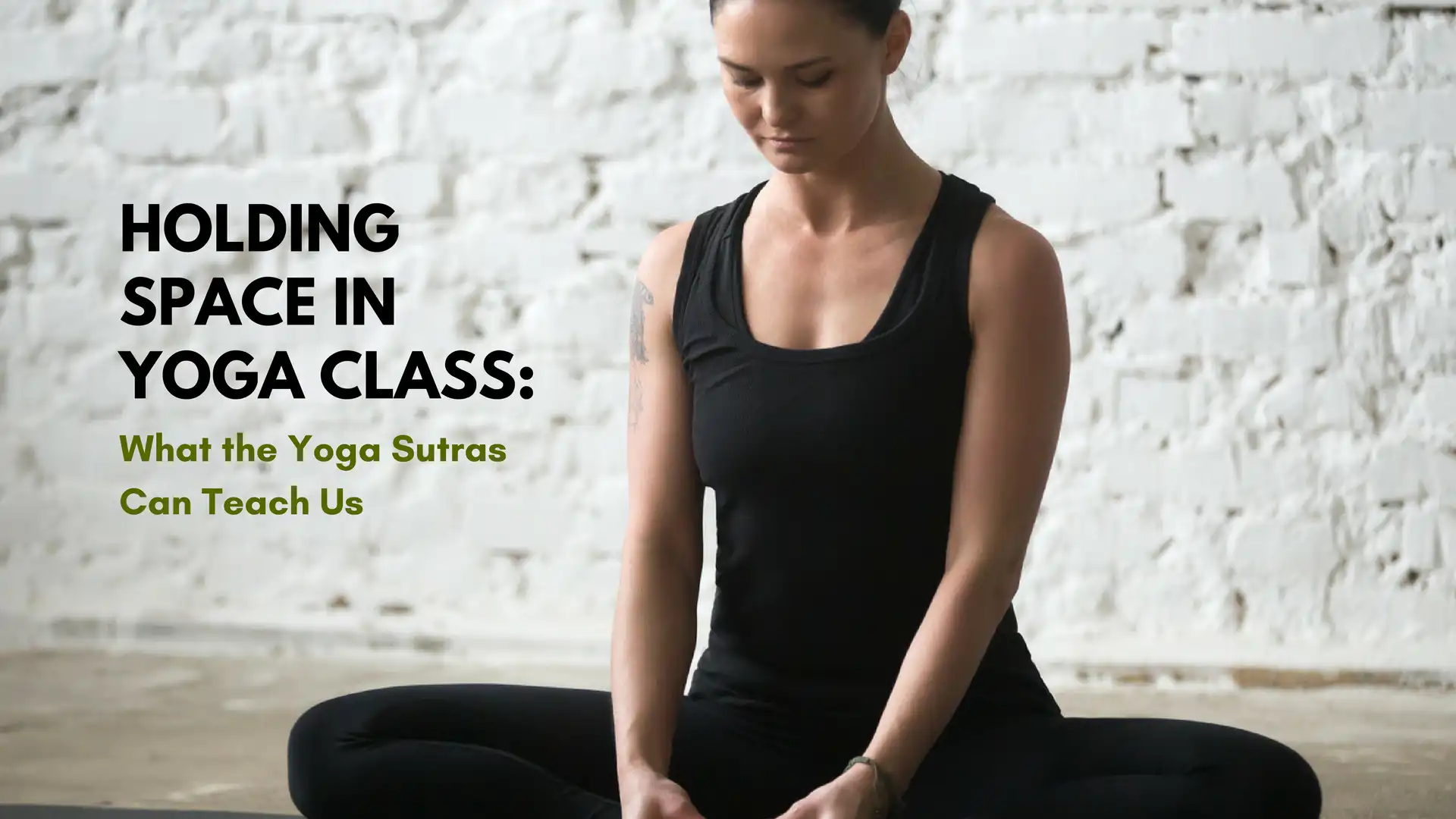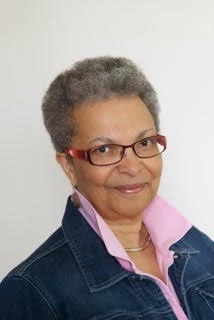Holding Space in Yoga Class: What the Yoga Sutras Can Teach Us

Holding space means that we are present for others or ourselves. We hold space by witnessing “what is,” without distraction, desire, or judgment. The focus of holding space is ideally on the process, not the outcome, even though the outcome of holding space may call for some type of action or response depending on the situation. For example, in my post Witnessing the Self, about holding space for my anger, I wrote:
“The act of witnessing my emotional state was like being in the eye of a hurricane. It calmed me and enabled me to be patient enough to watch my anger settle on its own.”
As a result of that witnessing process, I was able to take necessary action in a calm manner without re-attaching to my anger or the situation that triggered it.
Holding space is another way of expressing the concept of union, the meaning and ultimate goal of yoga. To shed light on the connection to yoga philosophy we need to look no further than the Yoga Sutras.
If you are looking for skillful means to work with the concept of holding space for yourselves or others in our five-sense, material small “self” world, you will find information, guidance, and tools to work with. If you are moving deeper into the mysteries of spirituality and want to work with the concept of holding space until you become the space as your universal “Self,” you will find information, guidance, and tools to work with at that deeper level as well. Since every journey begins with one step, let’s take a sutra from Samadhi Pada and see how it might apply to the concept of holding space. My choice is Sutra 1.2:
Yogas citta vritti nirodah
“Yoga is the ability to direct the mind exclusively toward an object and sustain that direction without any distractions” – T. K. V. Desikachar, The Heart of Yoga
Removing all distractions is a tall order but like every other goal worth reaching, it’s worth working toward. Working with the mind, then, is crucial to the ability to hold space. Holding space is part practice and part grace.
Therapists, counselors, and coaches hold space for their clients and patients. Yoga teachers hold space for their students. In A Hospice Nurse on Yoga for Grief Erin Collins describes her experience as a yoga student while grieving the loss of a relationship:
“Another kind and understanding teacher held space for me that day, when again I wept through the end of class. She stayed near me as I rested in Supta Baddhakonasana, my heart open to the skies and tears streaming down my cheeks. She placed a singing bowl upon my belly and chanted gently to the class, but also right to me. I was held.”
Here’s another scenario. As teachers, we may have a class plan prepared, with a theme, education, asana sequence, breath, and mudra practices, etc. We walk into the class and sense the energy of the group, and our carefully prepared plan goes out the window. What happens next, for me, is a moment of panic followed by a moment of grace in which an internal shift takes place. The distractions—my plan, my ego, and my desire to control—slide to the side and get put on an energetic shelf somewhere. Holding space for the class becomes my focus; I settle into the space and respond to the needs of the students so they can explore their bodies, their breath, and the workings of their minds based on where they are instead of where I wanted to them to be. It’s a “going with and being in the flow” kind of feeling of total calm and focus at the center while right action comes through. Both are happening at the same time.
Desikachar describes this as an aspect of pratyahara. Pratyahara, the fifth limb of yoga, is the withdrawal of the senses from any distractions and a sharpening of them toward the object or purpose at the same time. In this example he is holding space for an interaction with his audience:
“Although I stand in front of the audience with open eyes, I am so absorbed in the content of the discussion that my senses no longer react to other stimuli. Even if there were snow falling outside the window I would not notice; nor do I hear the sounds coming from outside the room. What is meant by pratyahara is that I create a situation in which my mind is so absorbed in something that the senses no longer respond to other objects.”
Iyengar, in Light on Life, puts it this way:
“In Sanskrit, pratyahara literally means, “to draw toward the opposite.” The normal movement of the senses is to flow outward where they encounter the objects of the world and name and interpret them with the aid of thought. These thoughts will probably be of acquisition (I want), rejection (I don’t want), or resignation (there’s nothing I can do about it). Rain, for example, will on different occasions elicit all three responses. Pratyahara, then, implies going against the grain, a difficult retraction, which is why it is often compared to a tortoise drawing his head, tail and four limbs back inside his shell. The yogi simply observes the fact, “it is raining,” he may think or say without desire or judgment.”
The ultimate goal of yoga is to be able to hold that “no desire, no judgment” space for everything; sunsets, war, love, death, babies, puppies, taxes, hate, and all the “isms” that exist in the world. As a yogi in training who believes in being honest, I’m a long way from being able to hold that kind of space for everything. I need a lot more practice both on and off the mat. But I’m a work in progress as are we all.
Iyengar says that pratyahara is where sustained practice (tapas) and self-knowledge (svadhyaya) come together. One way to practice this on the mat is yoga nidra. Yoga nidra is a systematic method to bring about physical, mental, and emotional conscious relaxation and self-awareness. The origins of yoga nidra are found in the ancient Tantric practice called nyasa (which means “to place” or “take the mind to that point”). The modern method that I use was developed by Satyananada Saraswati and is detailed in his book Yoga Nidra. In this guided practice, you slowly withdraw your senses from external distractions, such as sight and touch, and internal distractions sourced from the senses, such as memories, thoughts, and future projections.
In yoga nidra, you are encouraged to focus your mind on the chosen object and to “wake the witness.” Ideally, both the mind and the witness work together to take the awareness through all levels of being, starting with a comfortable trip through your body and your breath. This may be in a detailed rotation of consciousness through your body, part by part, followed by a breath inquiry. When it comes to the mind and emotions, yoga nidra offers several practices such as guided journeys or visualizations. The goal is to feel, stay with (hold space) and witness the workings of the mind and the emotions at the same time but only if one is ready to do so.
Yoga nidra practices can range from 20 minutes to 45 minutes. You can sit in a chair or lie down on the floor. The use of restorative props, such as bolsters and blankets, are highly recommended. In general yoga nidra is contraindicated for imbalanced psychological states and depression. However, individuals dealing with these conditions can choose a practice that keeps the focus on the body and the breath. I’ve been teaching yoga nidra for years in classes and workshops. My students love it.
Learn more about Yoga Nidra in Richard Miller’s course on YogaUOnline – Yoga, Body Awareness, and Resilience: New Findings on the Power of Body Sensing in Hatha Yoga.
Read another thoughtful article from YogaUOnline and writer Christine Malossi – Finding the Yogic Way: Uncovering the Jewell Within.
 BETH GIBBS MA, E-RYT 500, is a lifelong lover of movement and spent the first two and a half decades of her life dancing: tap, ballet, African and modern. She says she can dance to anything except heavy metal. She started her yoga practice in 1968, six months after her son was born and she’s been practicing ever since. She took her yoga teacher training with Joseph Le Page’s Integrative Yoga Therapy School in 1995 and currently teaches therapeutic yoga classes to children and adults with a specialty in classes for seniors in the Hartford, Connecticut area. Beth is a senior member of the IYT teaching faculty and directs the school’s Professional Yoga Therapist Internship Program. Her master’s degree from Lesley University in Cambridge, MA is in Yoga Therapy and Mind/Body Health. She still dances in her spare time For more information on her work see, www.proyogatherapeutics.com.
BETH GIBBS MA, E-RYT 500, is a lifelong lover of movement and spent the first two and a half decades of her life dancing: tap, ballet, African and modern. She says she can dance to anything except heavy metal. She started her yoga practice in 1968, six months after her son was born and she’s been practicing ever since. She took her yoga teacher training with Joseph Le Page’s Integrative Yoga Therapy School in 1995 and currently teaches therapeutic yoga classes to children and adults with a specialty in classes for seniors in the Hartford, Connecticut area. Beth is a senior member of the IYT teaching faculty and directs the school’s Professional Yoga Therapist Internship Program. Her master’s degree from Lesley University in Cambridge, MA is in Yoga Therapy and Mind/Body Health. She still dances in her spare time For more information on her work see, www.proyogatherapeutics.com.



